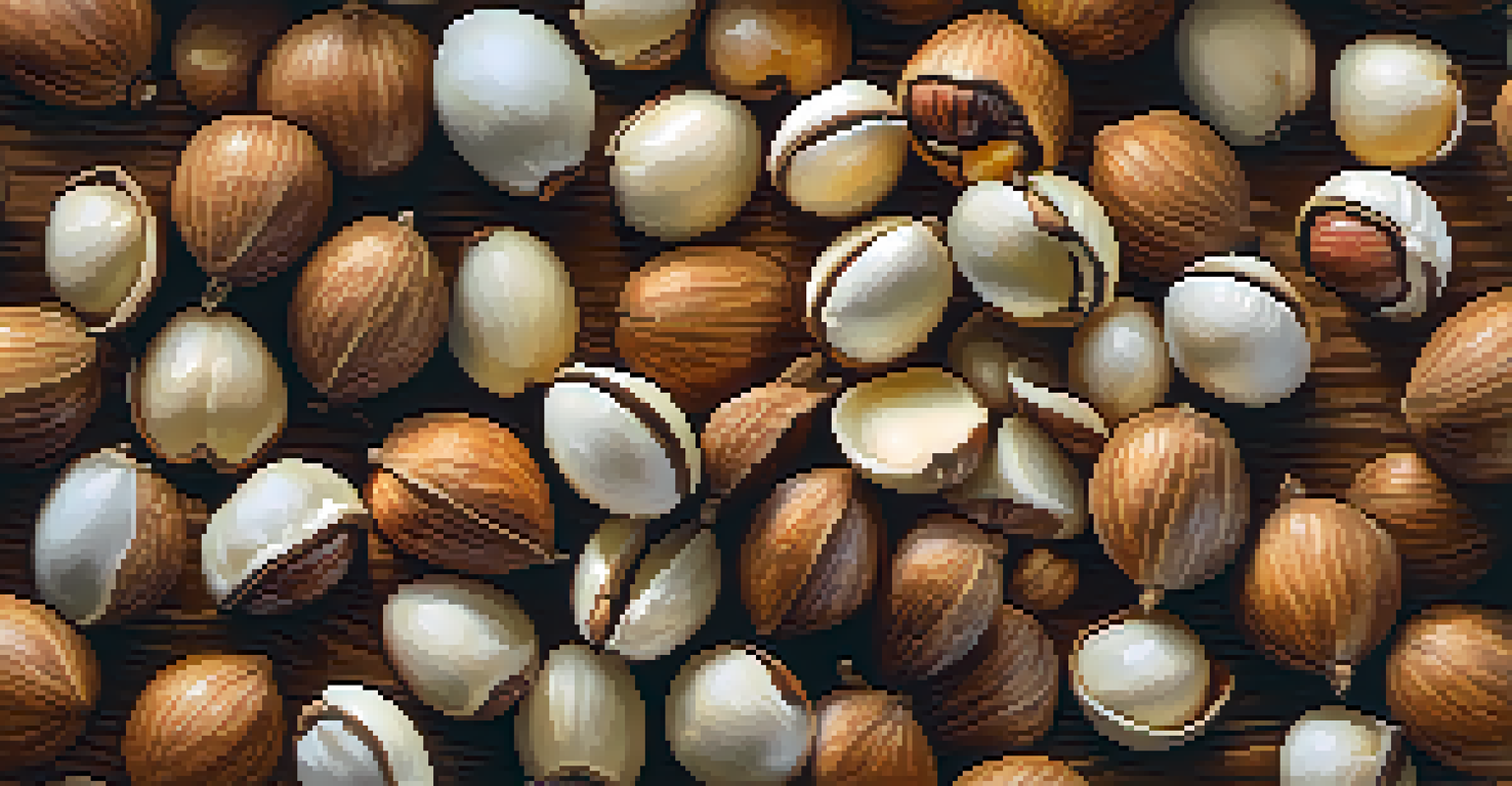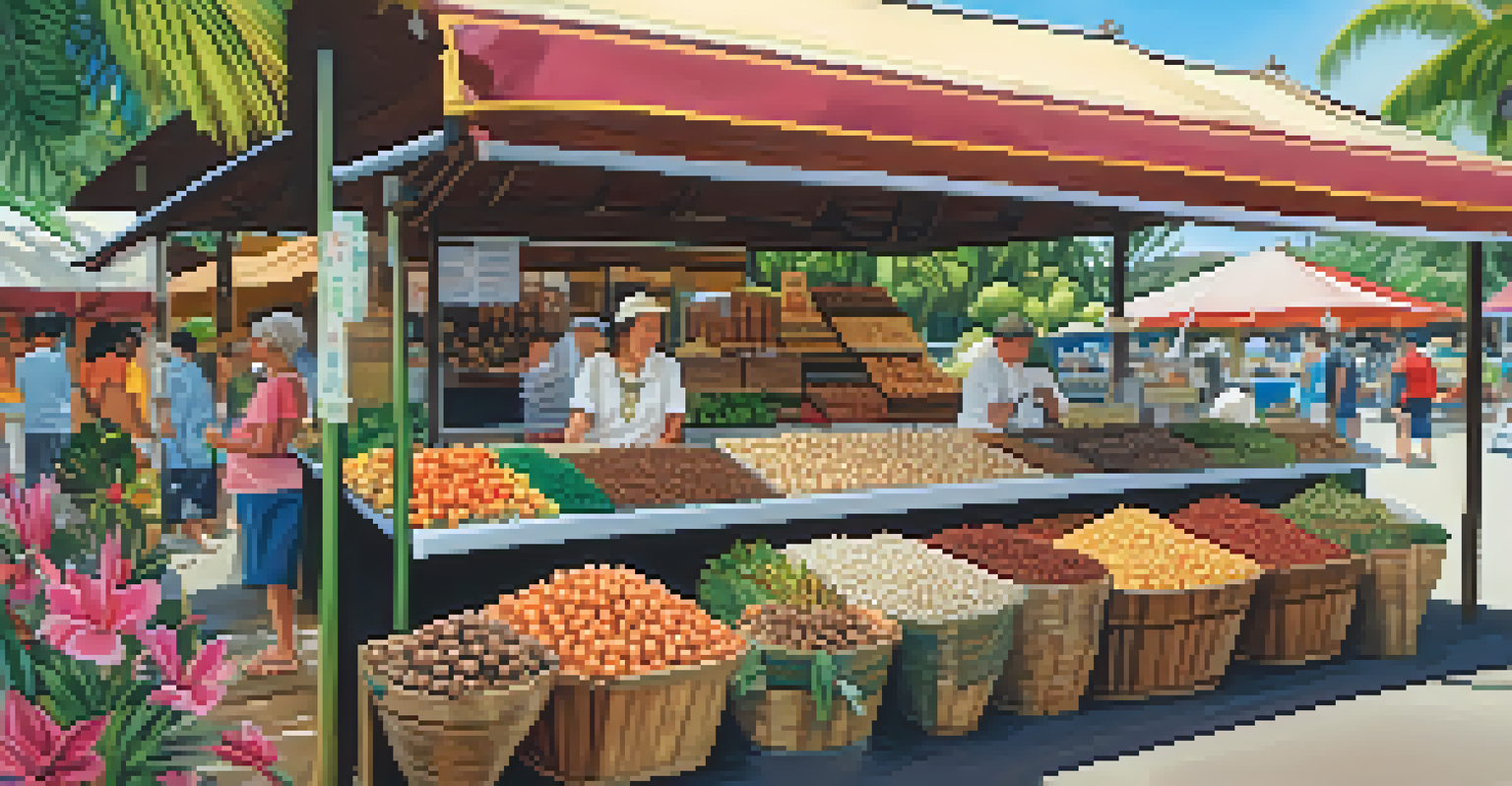Hawaii's Macadamia Nut Industry: Growth and Economic Value

The Origins of Macadamia Nuts in Hawaii
Macadamia nuts were introduced to Hawaii in the late 19th century, originating from Australia. Their rich flavor and buttery texture quickly made them a beloved treat among locals and visitors alike. Over the years, Hawaii's climate proved to be ideal for growing these nuts, giving rise to a flourishing industry.
Hawaii's macadamia nuts have become a symbol of Hawaiian culture, influencing not only local cuisine but also the global food market.
Today, Hawaii is the largest producer of macadamia nuts in the United States, accounting for nearly 90% of the nation's supply. This growth is largely due to the perfect combination of volcanic soil, consistent rainfall, and ample sunshine that the islands offer. Such environmental factors contribute significantly to the quality of the nuts, making them highly sought after.
In addition to being a culinary delight, macadamia nuts have also become a symbol of Hawaiian culture. Their unique flavor and versatility in various dishes—from cookies to gourmet entrees—have helped establish Hawaii's reputation in the global food market.
Economic Value of the Macadamia Nut Industry
The macadamia nut industry plays a vital role in Hawaii's economy, bringing in millions of dollars annually. In recent years, the industry has seen a remarkable growth trajectory, with exports reaching new heights. This economic contribution supports not only farmers but also local businesses involved in processing and distribution.

Moreover, the industry provides numerous jobs across the state, from agricultural roles to positions in marketing and sales. This job creation is essential in a state where employment opportunities can be limited, particularly in rural areas. The growth of the macadamia nut sector has thus become a lifeline for many families.
Macadamia Nuts Boost Hawaii's Economy
The macadamia nut industry significantly contributes to Hawaii's economy, generating millions in revenue and providing numerous jobs.
As the demand for healthy snacks increases, so does the market for macadamia nuts. Their reputation as a nutritious option has led to rising consumer interest, both domestically and internationally. This trend bodes well for the future of Hawaii's macadamia nut industry, promising continued economic benefits.
Sustainable Practices in Macadamia Farming
Sustainability is becoming increasingly important in agriculture, and Hawaii's macadamia nut farmers are leading the charge. Many growers are adopting organic farming practices, which not only enhance the quality of the nuts but also protect the environment. This commitment to sustainability resonates with consumers who are more eco-conscious than ever.
Sustainability is not just a trend; it's a necessary practice for the longevity of our agriculture and our planet.
Farmers are also investing in water conservation techniques and natural pest management systems, minimizing their ecological footprint. By focusing on sustainable practices, these growers ensure that they can continue producing high-quality nuts for generations to come. This approach not only benefits the environment but also enhances the marketability of their products.
The emphasis on sustainability has opened up new avenues for marketing, allowing farmers to share their stories and practices with consumers. As a result, they’re not just selling macadamia nuts; they’re selling a lifestyle that values environmental stewardship and quality.
The Role of Technology in the Industry
Technology is revolutionizing the macadamia nut industry, from farming to processing. Innovations such as precision agriculture help farmers monitor crop health and optimize yields. These advancements enable growers to use resources more efficiently, ultimately enhancing productivity and profitability.
Furthermore, processing technologies have improved the way nuts are harvested and packaged. Automated systems reduce labor costs and increase efficiency, allowing businesses to meet rising demand. Such technological integration is crucial for maintaining competitive pricing in a global market.
Sustainability Drives Farming Practices
Hawaii's macadamia nut farmers are adopting sustainable practices that not only enhance product quality but also protect the environment.
In addition, digital marketing strategies are helping local producers reach a broader audience. By leveraging social media and e-commerce platforms, Hawaii's macadamia nut farmers can showcase their products to consumers around the world, driving sales and expanding their brand presence.
Challenges Facing the Macadamia Nut Industry
Despite its successes, the macadamia nut industry faces several challenges that could impact its future. Factors such as climate change, pests, and diseases pose significant threats to nut production. Farmers must continuously adapt to these challenges to sustain their crops and livelihoods.
Moreover, the competition from other nut-producing regions, both domestically and internationally, is intensifying. Countries such as Australia and South Africa are also ramping up their macadamia nut production, which can affect market prices and demand. Staying competitive requires ongoing innovation and adaptation.
Additionally, labor shortages in Hawaii's agricultural sector can hinder growth. With fewer workers available for farm and processing jobs, the industry may struggle to keep up with increasing consumer demand. Addressing these labor issues will be essential for the industry's continued prosperity.
Cultural Impact of Macadamia Nuts in Hawaii
Macadamia nuts have woven themselves into the cultural fabric of Hawaii, influencing cuisine and traditions. They are featured in many local dishes, from traditional Hawaiian desserts to contemporary culinary creations. This integration into the local cuisine helps to celebrate Hawaiian heritage and promote its unique flavors.
Beyond the kitchen, macadamia nuts also play a role in local festivals and events. Various celebrations highlight the nut's significance, bringing communities together and fostering a sense of pride in local agriculture. These events not only promote the industry but also educate visitors about Hawaii's rich agricultural history.
Technology Transforms Nut Production
Innovative technologies are revolutionizing the macadamia nut industry, improving farming efficiency and expanding market reach.
Moreover, macadamia nuts have become a popular souvenir for tourists, serving as a tasty reminder of their Hawaiian experience. This connection to tourism further enhances the industry's economic impact, making it an essential component of Hawaii's identity and charm.
Future Outlook for Hawaii's Macadamia Nut Industry
Looking ahead, the future of Hawaii's macadamia nut industry appears promising. With consumer trends leaning toward healthy snacks and organic products, the demand for macadamia nuts is expected to continue rising. This trend creates opportunities for growth and innovation within the industry.
Additionally, ongoing investments in research and development will help farmers tackle challenges related to climate change and pests. By embracing new techniques and technologies, the industry can adapt and thrive in an evolving agricultural landscape. The focus on sustainability and quality will also enhance market competitiveness.

As Hawaii’s macadamia nut industry navigates these changes, it remains a vital part of the state's economy and culture. With a commitment to excellence and a focus on community, the industry is poised to grow and flourish for many years to come.